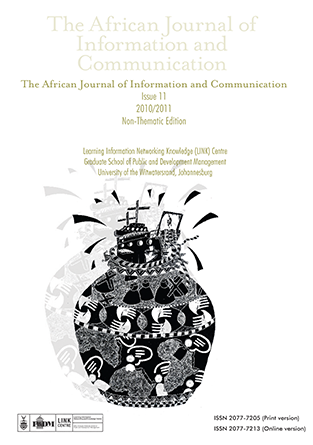Context-Aware VoIP Congestion Control Service
DOI:
https://doi.org/10.23962/10539/19721Keywords:
call admission control, context-awareness, ontology, semantic web, web ontology languageAbstract
IP networks can have difficulty coping with delay-sensitive VoIP traffics during emergency situations caused by fires and related disasters. During emergencies there is a huge increase in voice and video traffic, causing a huge strain on the network. The strain on the network is as a result of both essential and non-essential traffic. In such crisis situations, calls originating from or destined for rescue personnel, such as doctors and police, are considered essential. Any other calls from eyewitnesses and the public are considered non-essential, since they degrade the quality of service for the emergency response teams by consuming the scarce network resources. Providing the rescue team with the quality of service that they require necessitates network access restriction for non-essential traffic. In this paper, the authors present a voice and video service that uses Context-Awareness and Semantic Web technologies to restrict network access to privileged users during crisis situations. The service monitors the network for crisis conditions, enables the network to respond appropriately when a crisis occurs, detects the end of the crisis and reverts to its default state.
References
Ankolekar, A., Krötzsch, M., Tran, T. & Vrandecic, D. (2008). The two cultures: Mashing up Web 2.0 and the semantic web. Web Semantics: Science, Services and Agents on the World Wide Web, Volume 6, 70-75. https://doi.org/10.1016/j.websem.2007.11.002
Battle, R. & Benson, E. (2008). Bridging the semantic web and Web 2.0 with representational state transfer (REST). Web Semantics: Science, Services and Agents on the World Wide Web, Volume 6, No.1, 61-69. https://doi.org/10.1016/j.websem.2007.11.002
Baumgartner, N., Retschitzegger, W. & Schwinger, W. (2008). A software architecture for ontology-driven situation awareness. In Proceedings of the 23rd Annual ACM Symposium on Applied Computing Fortaleza, Ceará, Brazil, 16-20 March.
Chen, H., Finin, T. and Joshi, A. (2003) Using OWL in a Pervasive Computing Broker. In Proceedings of the Workshop on Ontologies in Agent Systems (OAS 2003), Melbourne, Australia.
Chung, S. & Chiu, C. (2002). Joint call admission control/congestion control for wireless integrated voice/data networks. Computer Communications, Volume 25, 1653-1664.
Costa, P. (2003). Towards a service platform for context-aware applications. Thesis for a Master of Science degree in Telematics, The University of Twente, Netherlands.
Estepa, A. & Estepa, R. (2008). Accurate resource estimation for homogeneous VoIP aggregated traffic. Computer Networks, Volume 52, No.13, 2505-2517.
Gao, D., Cai, J. & King, N. (2005). Admission control in IEEE 802.11e wireless LANs. Network, IEEE, Vol. 19, No. 4. (25 July 2005), 6-13.
Houck, D. & Meempat, G. (2002). Call admission control and load balancing for Voice over IP. Performance Evaluation, Volume 47, Issue 4, 243-253.
Jean, K. & Galis, A. (2005). A programmable context-aware voice service. London Communications Symposium. University College London, Department of Electronic & Electrical Engineering, Torrington Place, London.
Jones, G. (2005). Challenges and opportunities of context-aware information access. In Proceedings of the 2005 IEEE International Workshop on Ubiquitous Data Management (UDM), 53-60, 4 April.
Matheus, J., Kokar, M., Baclawski, K. & Letkowski, J.L. (2005). An application of semantic web technologies to situation awareness. In Proceedings of the Fourth International Semantic Web Conference (ISWC), 944-958, 6-10 November, Galway Ireland.
Ram, L., DaSilva, L.A., & Varadarajan, S. (2003). Admission control by implicit signaling in support of Voice over IP over ADSL. The International Journal of Computer and Telecommunications Networking. Volume 44 Issue 6, 22 April.
Sheriff, I., Aravinda, P., Acharya, P. & Belding, M. (2008). Measurement-driven admission control on wireless backhaul networks. Computer Communications, Volume 31, Issue 7, 1354-1371.
Sotoodeh, M. (2007). Ontology-based semantic interoperability in emergency management. Thesis for a Doctor of Philosophy degree in the Department Electrical and Computer Engineering, University of British Columbia, Vancouver.
Wang, H., He, B. & Agrawal, D. (2007). Above packet level admission control and bandwidth allocation for IEEE 802.16 wireless MAN. Simulation Modelling Practice and Theory, Volume 15, 366-382.
Wei, H., Kim, K., Kashyap, A. & Ganguly, S. (2006). On admission of VoIP calls over wireless mesh network. In Proceedings of IEEE International Conference on Communications, 11-15 June, Istanbul, 1990-1995.
Downloads
Published
Issue
Section
License
Copyright (c) 2011 https://creativecommons.org/licenses/by/4.0

This work is licensed under a Creative Commons Attribution 4.0 International License.
How to Cite
- Abstract 232
- pdf 74


.png)